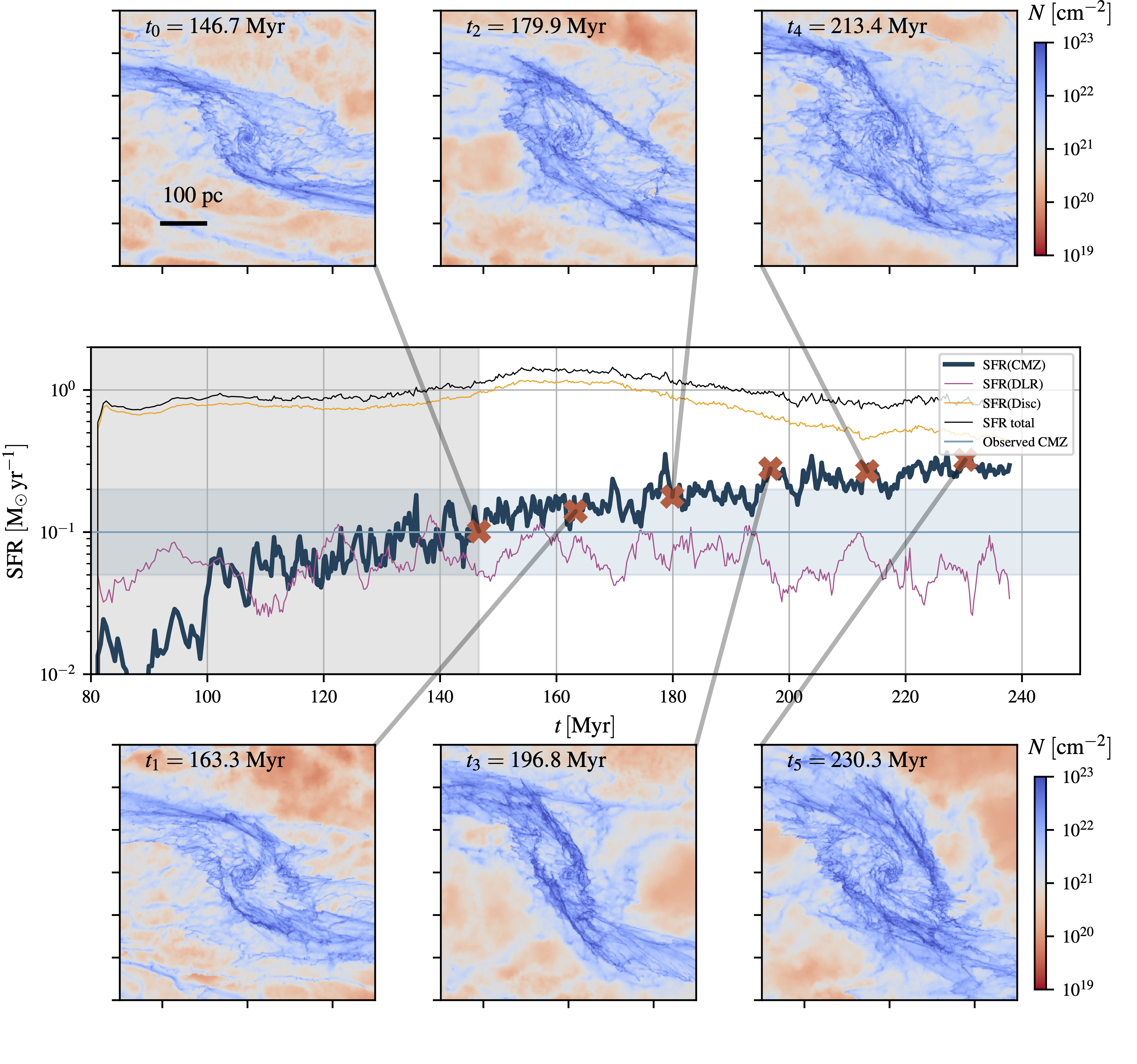
Simulations of the Milky Way's central molecular zone - II. Star formation
Sormani, Tress et al. (2020), MNRAS,497,5024 [Download paper]
The Milky Way's central molecular zone (CMZ), i.e. the star-forming nuclear ring at R≲200 pc, has emerged in recent years as a unique laboratory for the study star formation, owing to the fact that the environmental conditions under which stars are born are markedly different from anywhere else in the Galaxy. In this paper we use the hydrodynamical simulations presented in a companion paper (Tress et al. 2020) to investigate star formation in the CMZ. The simulations comprise the gas flow in the whole inner disc (R < 5 kpc) of the Milky Way, which allows us to assess how the larger-scale environment and the bar-driven inflow affect the formation of stars in the CMZ. We include a non-equilibrium time-dependent chemical network and comfortably reach sub-parsec resolution which allows us to resolve individual molecular clouds very well. Our main findings are as follows. (1) By studying the spatial and temporal distribution of stars formed along the CMZ ring, we find that most of the star formation happens downstream of the apocentres, consistent with the ``pearls-on-a-string'' scenario. (2) Our simulations do not support the notion that an absolute evolutionary timeline of star formation triggered by pericentre passage can be identified as gas clouds orbit in the CMZ ring. (3) Within the timescale of our simulation (~100 Myr), the depletion time of the CMZ is constant within a factor of ~2. This suggests that variations in the star formation rate are primarily driven by variations in the mass of the CMZ, caused for example by changes in the bar-driven inflow rate, AGN feedback, or other external events, and not by variations in the depletion time. (4) We study the trajectories of newly born stars in our simulations. We find several examples that have age, line-of-sight velocity and proper motion velocity compatible with the Arches and Quintuplet clusters. Our simulation suggests that these prominent clusters originate near the collision sites where the bar-driven inflow accretes onto the CMZ, at symmetrical locations with respect to the Galactic centre, and that they have already decoupled from the gas in which they were born.

Simulations of the Milky Way's central molecular zone - I. Gas dynamics
Tress, Sormani et al. (2020), MNRAS accepted [Download paper]
In this and in a companion paper we use hydrodynamical simulations to study the Milky Way's central molecular zone (CMZ), i.e. the star-forming nuclear ring at Galactocentric radii R≲200 pc. In this paper we focus on the gas dynamics, while in the companion paper we focus on the star formation. The simulations comprise the gas flow in a Milky Way barred potential out to R=5 kpc, which is necessary in order to capture the large-scale environment in which the CMZ is embedded and with which it is strongly interacting through the bar-driven inflow. The simulations also include a non-equilibrium time-dependent chemical network, gas self-gravity, and a sub-grid model for star formation and supernova feedback, all while reaching sub-parsec resolution in the densest regions. Our main findings are as follows: (1) The distinction between inner (R≲120 pc) and outer (120≲R≲450 pc) CMZ that is sometimes proposed in the literature is unnecessary. Instead, the CMZ is best described as single structure, namely a star-forming ring with outer radius R≈200 pc which is interacting directly with the bar-driven inflow mediated by the so called ``dust lanes''. (2) This accretion can induce a significant tilt of the CMZ out of the plane. A tilted CMZ might provide an alternative explanation to the infinity-shaped structure identified in Herschel data by Molinari et al. 2011. (3) The bar in our simulation efficiently drives an inflow from the Galactic disc (R≈3kpc) down to the CMZ (R=200 pc) of the order of 1 Msun/yr, consistent with observational determinations. (4) Self-gravity and supernovae feedback can drive an inflow from the CMZ inwards towards the circumnuclear disc of the order of ~0.03 Msun/yr. (5) We give a new interpretation for the 3D placement of the 20 and 50 km/s clouds, according to which they are close (R ≲ 30 pc) to the Galactic centre, but are also connected to the larger-scale streams at R≈100 pc.
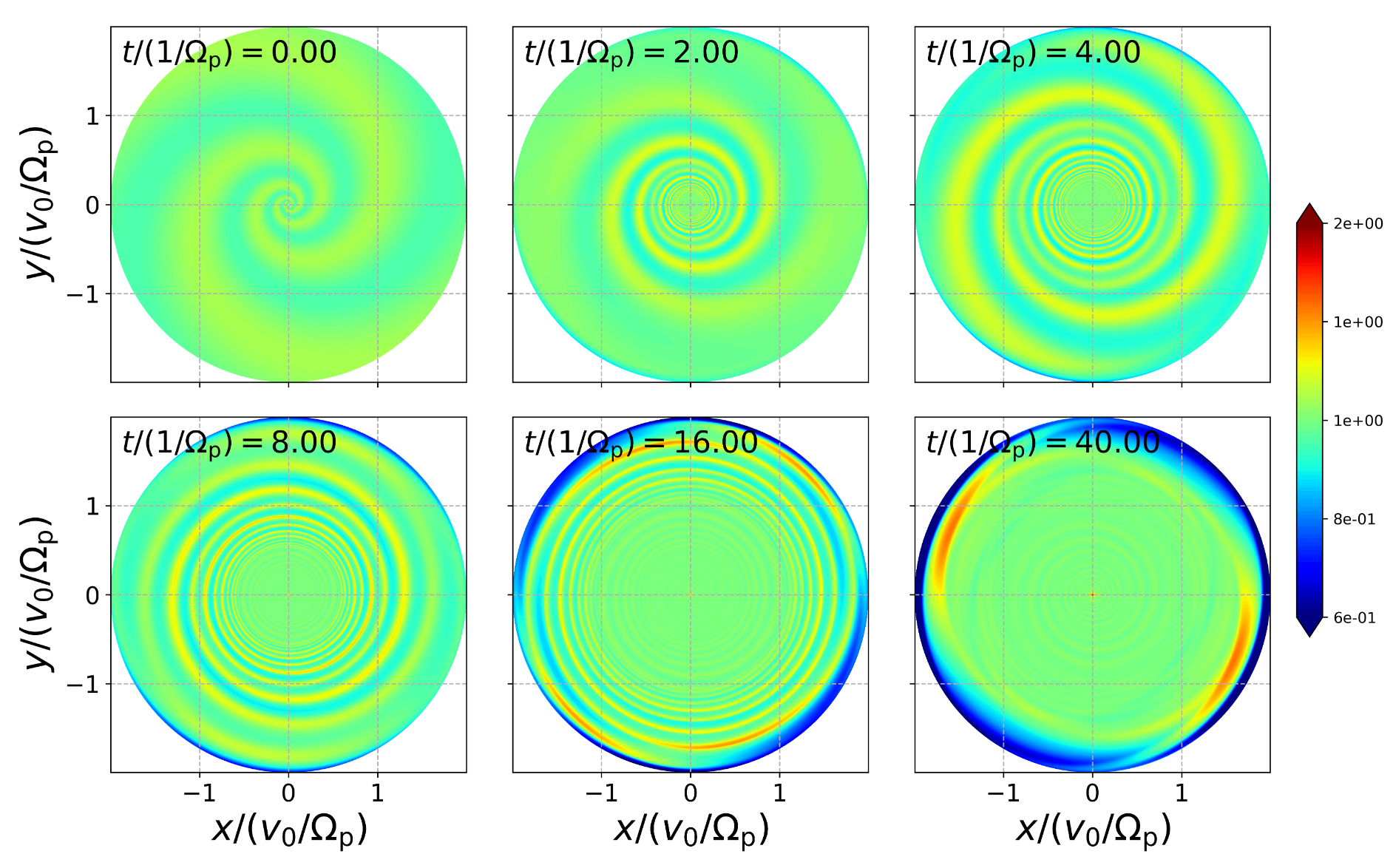
Do nuclear rings in barred galaxies form at the shear minimum of the rotation curve?
Sormani & Li (2020), MNRAS,494,6030 [ADS link]
It has been recently suggested that (i) nuclear rings in barred galaxies (including our own Milky Way) form at the radius where the shear parameter of the rotation curve reaches a minimum; (ii) the acoustic instability of Montenegro et al. is responsible for driving the turbulence and angular momentum transport in the central regions of barred galaxies. Here we test these suggestions by running simple hydrodynamical simulations in a scale-free logarithmic barred potential. Since the rotation curve of this potential is scale-free, the shear minimum theory predicts that no ring should form. We find that in contrast to this prediction, a ring does form in the simulation, with morphology consistent with that of nuclear rings in real barred galaxies. This proves that the presence of a shear-minimum is not a necessary condition for the formation of a ring. We also find that perturbations that are predicted to be acoustically unstable wind up and eventually propagate off to infinity, so that the system is actually stable. We conclude that (i) the shear-minimum theory is an unlikely mechanism for the formation of nuclear rings in barred galaxies; (ii) the acoustic instability is a spurious result and may not be able to drive turbulence in the interstellar medium, at least for the case without self-gravity. The question of the role of turbulent viscosity remains open.
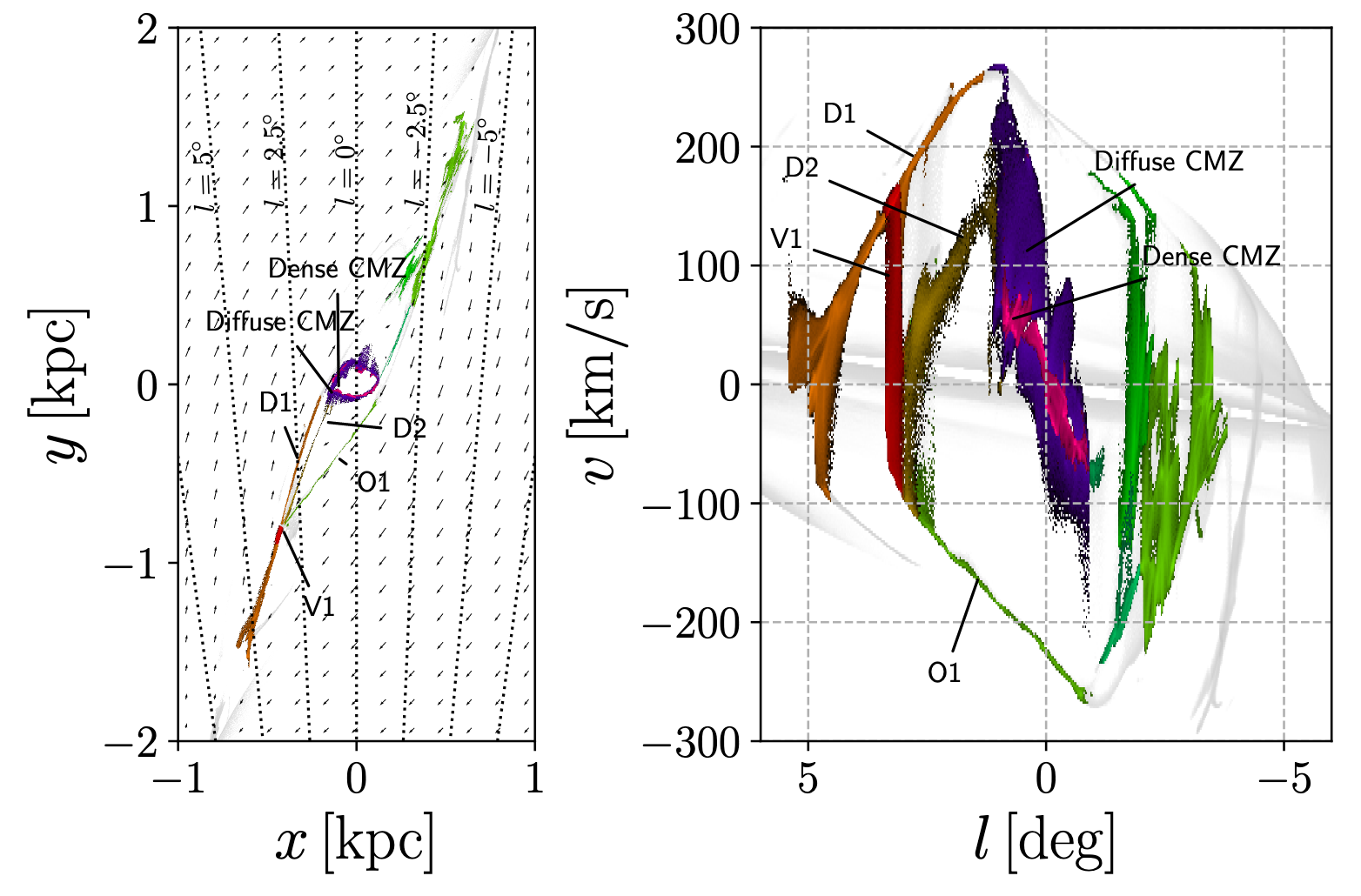
The geometry of the gas surrounding the Central Molecular Zone: on the origin of localized molecular clouds with extreme velocity dispersions
Sormani et al. (2019), MNRAS,488,4663 [ADS link]
Observations of molecular gas near the Galactic Centre (|l| < 10°, |b| < 1°) reveal the presence of a distinct population of enigmatic compact clouds that are characterized by extreme velocity dispersions (∆ v > 100 km/s). These extended velocity features are very prominent in the data cubes and dominate the kinematics of molecular gas just outside the Central Molecular Zone (CMZ). The prototypical example of such a cloud is Bania Clump 2. We show that similar features are naturally produced in simulations of gas flow in a realistic barred potential. We analyse the structure of the features obtained in the simulations and use this to interpret the observations. We find that the features arise from collisions between material that has been infalling rapidly along the dust lanes of the Milky Way bar and material that belongs to one of the following two categories: (i) material that has `overshot' after falling down the dust lanes on the opposite side; (ii) material which is part of the CMZ. Both types of collisions involve gas with large differences in the line-of-sight velocities, which is what produces the observed extreme velocity dispersions. Examples of both categories can be identified in the observations. If our interpretation is correct, we are directly witnessing (a) collisions of clouds with relative speeds of ∼ 200 km/s and (b) the process of accretion of fresh gas onto the CMZ.
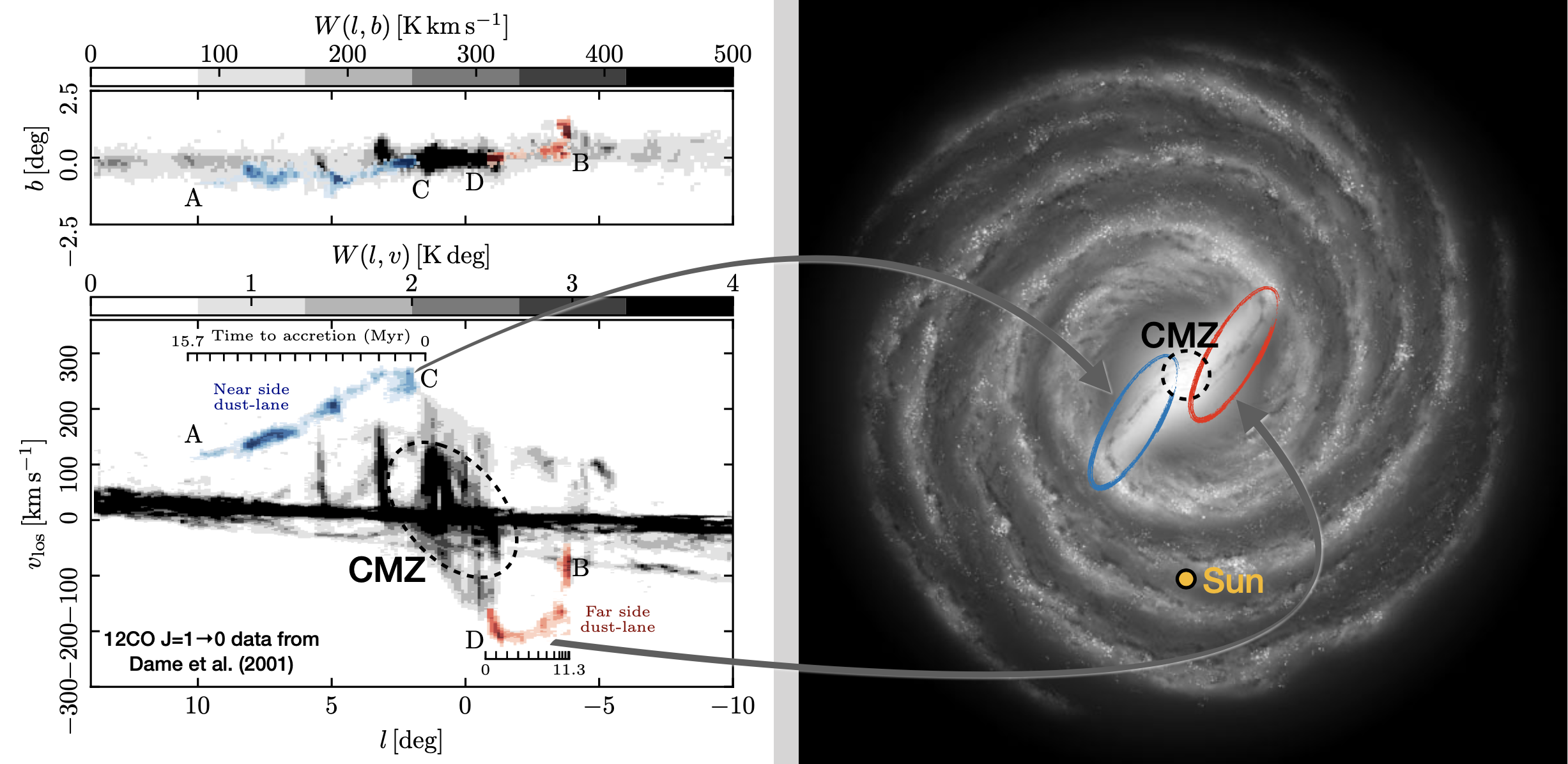
Mass inflow rate into the Central Molecular Zone: observational determination and evidence of episodic accretion
Sormani & Barnes (2019), MNRAS,484,1213 [ADS link]
It is well known that the Galactic bar drives a gas inflow into the Central Molecular Zone, which fuels star formation, accretion on to the central supermassive black hole, and large-scale outflows. This inflow happens mostly through two symmetrical dust lanes, similar to those often seen in external barred galaxies. Here, we use the fact that the Milky Way dust lanes have been previously identified in 12CO datacubes and a simple geometrical model to derive the first observational determination of the mass inflow rate into the Central Molecular Zone. We find that the time-averaged inflow rate along the near-side dust lane is 1.2^{+0.7}_{-0.8} M_☉ yr^{-1} and along the far-side dust lane is 1.5^{+0.9}_{-1.0} M_☉ yr^{-1}, which gives a total inflow of 2.7^{+1.5}_{-1.7} M_☉ yr^{-1}. We also provide the time series of the inflow rate \dot{M} for the future few Myr. The latter shows that the inflow rate is variable with time, supporting a scenario of episodic accretion on to the Central Molecular Zone.
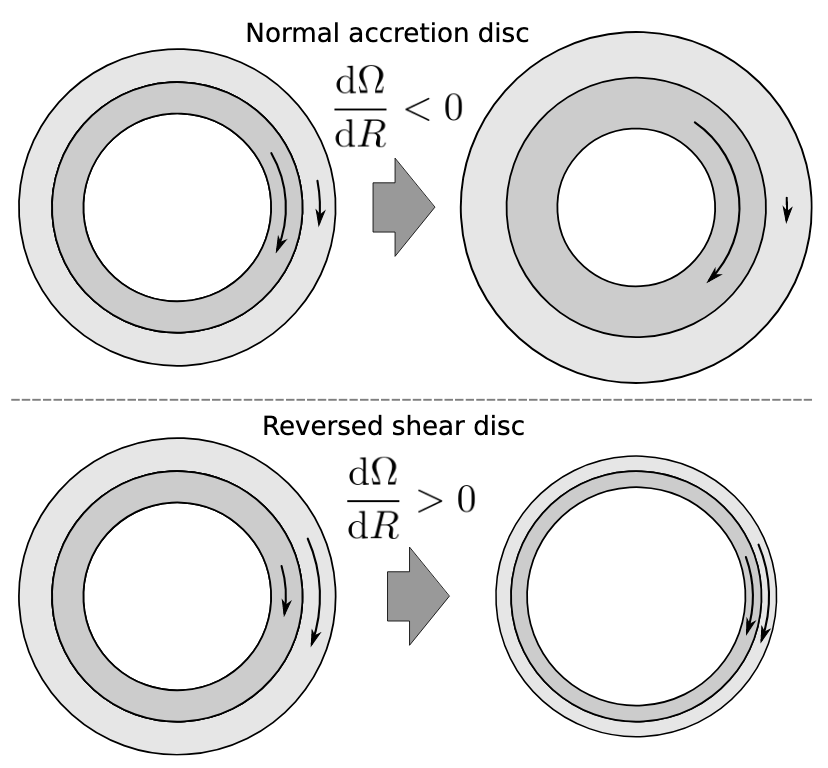
A dynamical mechanism for the origin of nuclear rings
Sormani et al. (2018), MNRAS,475,2383 [ADS link]
We develop a dynamical theory for the origin of nuclear rings in barred galaxies. In analogy with the standard theory of accretion discs, our theory is based on shear viscous forces among nested annuli of gas. However, the fact that gas follows non-circular orbits in an external barred potential has profound consequences: it creates a region of reverse shear in which it is energetically favourable to form a stable ring that does not spread despite dissipation. Our theory allows us to approximately predict the size of the ring given the underlying gravitational potential. The size of the ring is loosely related to the location of the Inner Lindblad Resonance in the epicyclic approximation, but the predicted location is more accurate and is also valid for strongly barred potentials. By comparing analytical predictions with the results of hydrodynamical simulations, we find that our theory provides a viable mechanism for ring formation if the effective sound speed of the gas is low (c_s≲ 1 {km s^{-1}}), but that nuclear spirals/shocks created by pressure destroy the ring when the sound speed is high (c_s∼eq 10 {km s^{-1}}). We conclude that whether this mechanism for ring formation is relevant for real galaxies ultimately depends on the effective equation of state of the interstellar medium (ISM). Promising confirmation comes from simulations in which the ISM is modelled using state-of-the-art cooling functions coupled to live chemical networks, but more tests are needed regarding the role of turbulence driven by stellar feedback. If the mechanism is relevant in real galaxies, it could provide a powerful tool to constrain the gravitational potential, in particular the bar pattern speed.
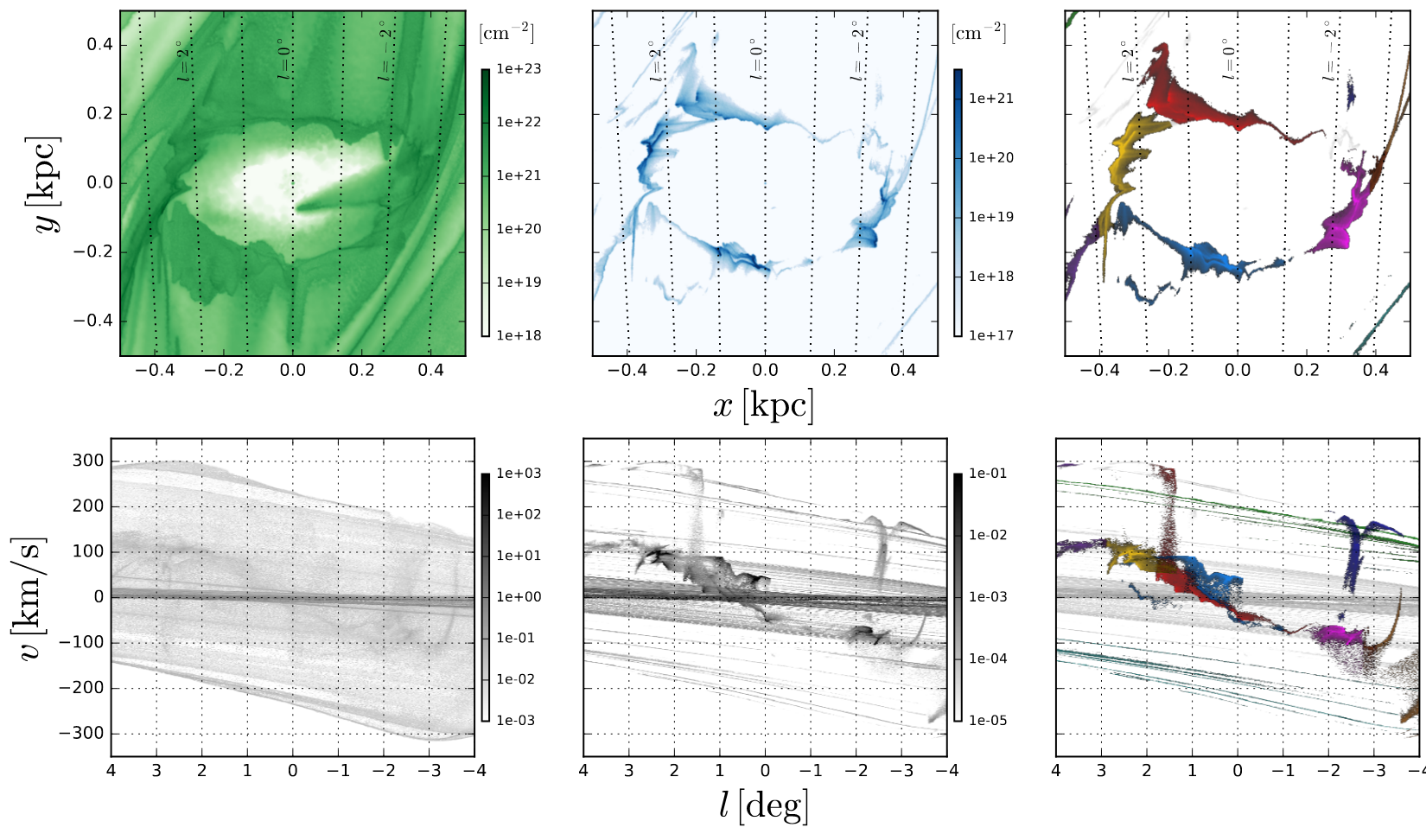
A theoretical explanation for the Central Molecular Zone asymmetry
Sormani et al. (2018), MNRAS,475,2383 [ADS link]
It has been known for more than 30 yr that the distribution of molecular gas in the innermost 300 parsecs of the Milky Way, the Central Molecular Zone, is strongly asymmetric. Indeed, approximately three quarters of molecular emission come from positive longitudes, and only one quarter from negative longitudes. However, despite much theoretical effort, the origin of this asymmetry has remained a mystery. Here, we show that the asymmetry can be neatly explained by unsteady flow of gas in a barred potential. We use high-resolution 3D hydrodynamical simulations coupled to a state-of-the-art chemical network. Despite the initial conditions and the bar potential being point symmetric with respect to the Galactic Centre, asymmetries develop spontaneously due to the combination of a hydrodynamical instability known as the `wiggle instability' and the thermal instability. The observed asymmetry must be transient: observations made tens of megayears in the past or in the future would often show an asymmetry in the opposite sense. Fluctuations of amplitude comparable to the observed asymmetry occur for a large fraction of time in our simulations, and suggest that the present is not an exceptional moment in the life of our Galaxy.
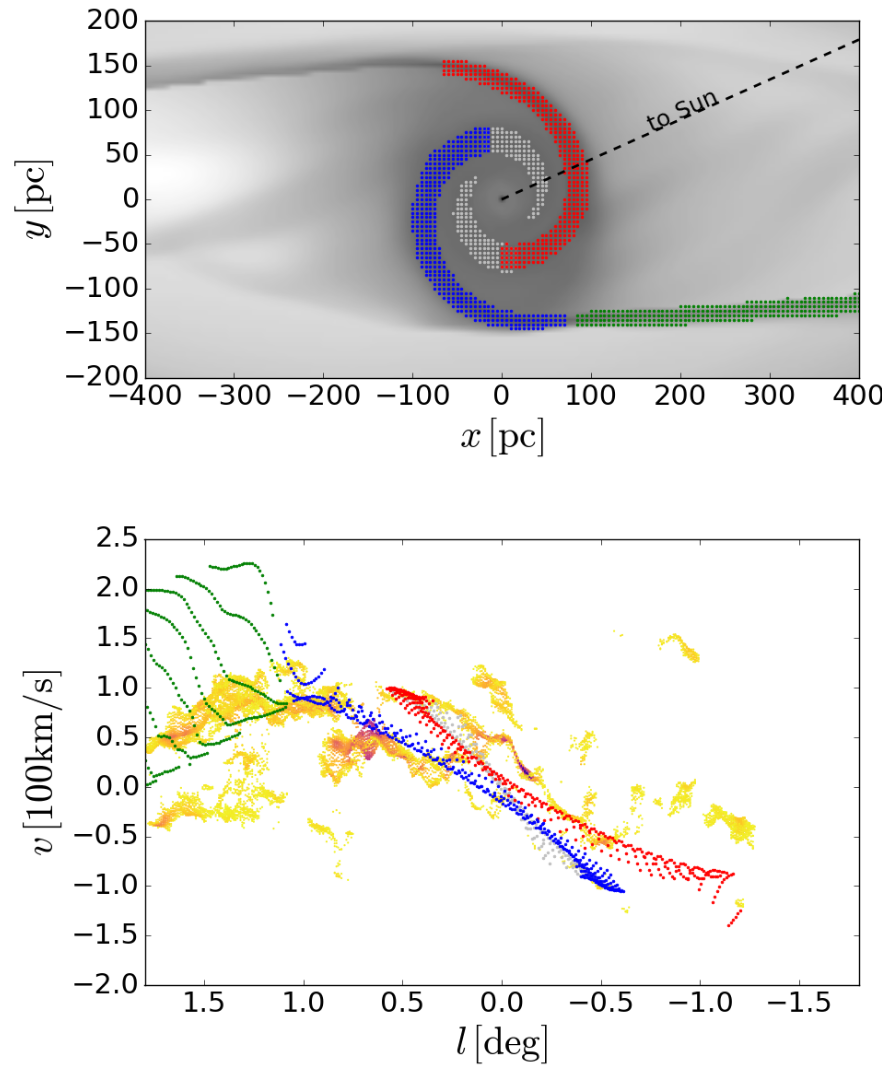
Nuclear spirals in the inner Milky Way
Ridley, Sormani et al. (2017), MNRAS,469,2251 [ADS link]
We use hydrodynamical simulations to construct a new coherent picture for the gas flow in the Central Molecular Zone (CMZ), the region of our Galaxy within R ≲ 500 pc. We relate connected structures observed in (l, b, v) data cubes of molecular tracers to nuclear spiral arms. These arise naturally in hydrodynamical simulations of barred galaxies, and are similar to those that can be seen in external galaxies such as NGC 4303 or NGC 1097. We discuss a face-on view of the CMZ, including the positions of several prominent molecular clouds, such as Sgr B2, the 20 and 50 km s-1 clouds, the polar arc, Bania Clump 2 and Sgr C. Our model is also consistent with the larger scale gas flow, up to R ≃ 3 kpc, thus providing a consistent picture of the entire Galactic bar region.
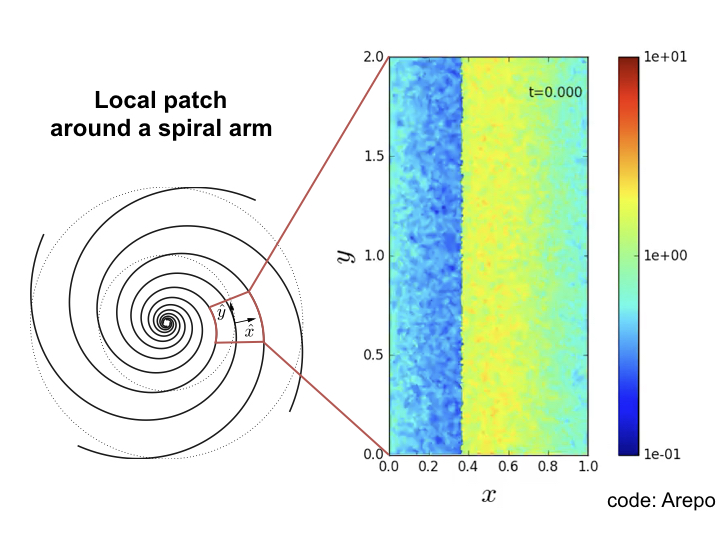
Periodicity makes galactic shocks unstable - I. Linear analysis
Sormani et al. (2017), MNRAS,471,2932 [ADS link]
We study the dynamical stability of stationary galactic spiral shocks. The steady-state equilibrium flow contains a shock of the type derived by Roberts in the tightly wound approximation. We find that boundary conditions are critical in determining whether the solutions are stable or not. Shocks are unstable if periodic boundary conditions are imposed. For intermediate strengths of the spiral potential, the instability disappears if boundary conditions are imposed such that the upstream flow is left unperturbed as in the classic analysis of D'yakov and Kontorovich. This reconciles apparently contradictory findings of previous authors regarding the stability of spiral shocks. This also shows that the instability is distinct from the Kelvin-Helmholtz instability, confirming the findings of Kim et al. We suggest that instability is a general characteristics of periodic shocks, regardless of the presence of shear, and provide a physical picture as to why this is the case. For strong spiral potentials, high post-shock shear makes the system unstable also to parasitic Kelvin-Helmholtz instability regardless of the boundary conditions. Our analysis is performed in the context of a simplified problem that, while preserving all the important characteristics of the original problem, strips it from unnecessary complications, and assumes that the gas is isothermal, non-self-gravitating, non-magnetized.

Gas flow in barred potentials - III. Effects of varying the quadrupole
Sormani, Binney & Magorrian (2015), MNRAS,454,1818 [ADS link]
We run hydrodynamical simulations of a 2D isothermal non-self-gravitating inviscid gas flowing in a rigidly rotating externally imposed potential formed by only two components: a monopole and a quadrupole. We explore systematically the effects of varying the quadrupole while keeping fixed the monopole and discuss the consequences for the interpretation of longitude-velocity diagrams in the Milky Way. We find that the gas flow can constrain the quadrupole of the potential and the characteristics of the bar that generates it. The exponential scale length of the bar must be at least 1.5 kpc. The strength of the bar is also constrained. Our global interpretation favours a pattern speed of Ω = 40 km s-1 kpc-1. We find that for most observational features, there exist a value of the parameters that matches each individual feature well, but is difficult to reproduce all the important features at once. Due to the intractably high number of parameters involved in the general problem, quantitative fitting methods that can run automatic searches in parameter space are necessary.

Gas flow in barred potentials - II. Bar-driven spiral arms
Sormani, Binney & Magorrian (2015), MNRAS,451,3437 [ADS link]
Spiral arms that emerge from the ends of a galactic bar are important in interpreting observations of our and external galaxies. It is therefore important to understand the physical mechanism that causes them. We find that these spiral arms can be understood as kinematic density waves generated by librations around underlying ballistic closed orbits. This is even true in the case of a strong bar, provided the librations are around the appropriate closed orbits and not around the circular orbits that form the basis of the epicycle approximation. An important consequence is that it is a potential's orbital structure that determines whether a bar should be classified as weak or strong, and not crude estimates of the potential's deviation from axisymmetry.

Gas flow in barred potentials
Sormani, Binney & Magorrian (2015), MNRAS,449,2421 [ADS link]
We use a Cartesian grid to simulate the flow of gas in a barred Galactic potential and investigate the effects of varying the sound speed in the gas and the resolution of the grid. For all sound speeds and resolutions, streamlines closely follow closed orbits at large and small radii. At intermediate radii shocks arise and the streamlines shift between two families of closed orbits. The point at which the shocks appear and the streamlines shift between orbit families depends strongly on sound speed and resolution. For sufficiently large values of these two parameters, the transfer happens at the cusped orbit as hypothesized by Binney et al. over two decades ago. For sufficiently high resolutions, the flow downstream of the shocks becomes unsteady. If this unsteadiness is physical, as appears to be the case, it provides a promising explanation for the asymmetry in the observed distribution of CO.